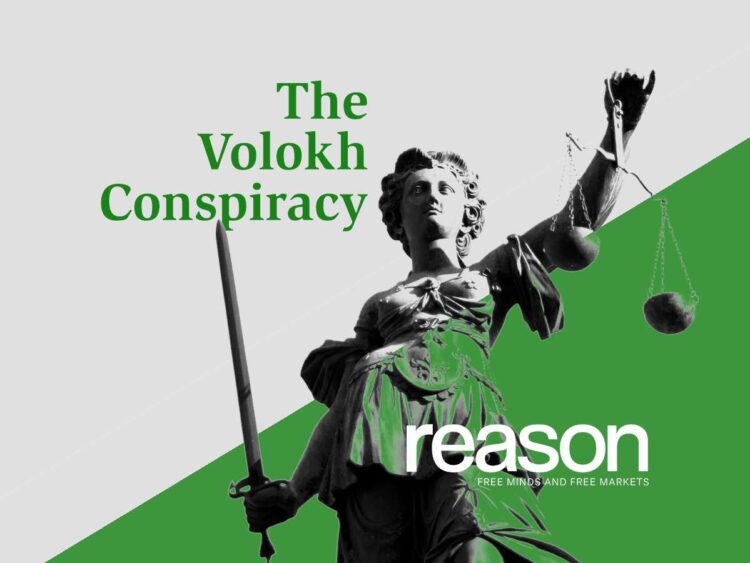Lately, Jonathan Gienapp printed a new e book that challenges originalism as inconsistent with how the Framers understood the Structure. The title says all of it: “In opposition to Constitutional Originalism.” The e book has already acquired extraordinarily favorable opinions. Lots of these constructive opinions are from people who find themselves not themselves constitutional originalists. For a opposite opinion, I might suggest a important commentary from John McGinnis and Mike Rappaport, who method the e book from the angle of originalists.
Right here is the introductory paragraph:
Along with his new e book In opposition to Constitutional Originalism, Stanford historian Jonathan Gienapp has garnered effusive reward from these desperate to undermine the originalist enterprise. For these interested in the originalist venture, nevertheless, the e book is unlikely to steer. Quite the opposite, it highlights the persistent difficulties historians face after they enterprise into constitutional interpretation. Gienapp neglects probably the most main of sources—the Structure—its textual content, construction, and self-referential nature. He compounds this oversight by privileging mere disagreement amongst historic actors over rigorous analysis of their arguments, a trademark of authorized reasoning. He additionally confuses objections to originalism as an interpretive technique with objections to explicit readings of the unique that means. Lastly, Gienapp typically fails to situate the Structure within the transformative historic second of its creation, significantly the Founders’ disillusionment with the unwritten British structure. These deficiencies weaken his case and, satirically, reinforce the mental energy of originalism, which at its finest rigorously takes account of textual content and context.
One instance about Hamilton caught out:
Gienapp accurately observes that some people within the runup to drafting and ratification believed {that a} structure prolonged past the doc itself. However the Philadelphia Conference rejected that understanding. As soon as the Structure was ratified, advocates and jurists argued primarily from its textual content. Gienapp’s remedy of Alexander Hamilton is emblematic of this error. He cites Hamilton’s well-known line—”the sacred rights of mankind are to not be rummaged for amongst outdated parchments”—to counsel skepticism about written constitutions. But Gienapp omits important context: Hamilton made this comment in 1775, lengthy earlier than the drafting of the Structure, and as a part of an argument towards British parliamentary supremacy. By the point of the Founding, Hamilton’s views, like these of his contemporaries, had developed. As a Federalist creator and Secretary of the Treasury, Hamilton embraced the Structure as a written, mounted normal. Gienapp’s omission right here is just not merely an oversight; it exemplifies his tendency to make use of understandings from a lot earlier or later than the Structure’s enactment.
In contrast, Gienapp doesn’t focus on issues Hamilton stated after our Structure was ratified:
The burden of proof from the Structure’s proponents additionally helps the inferences from the doc itself that it’s authorized. For example, in 1791 Alexander Hamilton wrote the Structure needs to be interpreted “in response to the standard [and] established guidelines of building,” definitely implying he regarded it as a authorized doc. Whereas Gienapp does quote from Hamilton’s opinion on the financial institution, he by no means discusses this statement, which appears rather more related to the character of constitutional interpretation than what Hamilton stated in 1775.
To a authorized historian, it could not matter a lot what Hamilton stated, and when he stated it. However for an originalist, these particulars actually do matter.
Right here is the conclusion:
Finally, Gienapp’s In opposition to Constitutional Originalism is a irritating e book. It lectures originalists on the significance of historical past however fails to take severely the first historic artifact at challenge: the Structure itself. Gienapp ignores the historians’ obligation to weigh conflicting proof, typically favoring provocative claims over measured judgment. Most surprisingly, he additionally neglects the Revolutionary expertise that led the founders to create, within the phrases of Justice William Paterson, a elementary written legislation of “exactitude and precision” on which to discovered a brand new nation.
I do not assume anyone e book can settle the talk about originalism. However I believe the sustained assaults of this doctrine is, whether or not critics admit it or not, a mirrored image of the energy of originalism.
Lately, Jonathan Gienapp printed a new e book that challenges originalism as inconsistent with how the Framers understood the Structure. The title says all of it: “In opposition to Constitutional Originalism.” The e book has already acquired extraordinarily favorable opinions. Lots of these constructive opinions are from people who find themselves not themselves constitutional originalists. For a opposite opinion, I might suggest a important commentary from John McGinnis and Mike Rappaport, who method the e book from the angle of originalists.
Right here is the introductory paragraph:
Along with his new e book In opposition to Constitutional Originalism, Stanford historian Jonathan Gienapp has garnered effusive reward from these desperate to undermine the originalist enterprise. For these interested in the originalist venture, nevertheless, the e book is unlikely to steer. Quite the opposite, it highlights the persistent difficulties historians face after they enterprise into constitutional interpretation. Gienapp neglects probably the most main of sources—the Structure—its textual content, construction, and self-referential nature. He compounds this oversight by privileging mere disagreement amongst historic actors over rigorous analysis of their arguments, a trademark of authorized reasoning. He additionally confuses objections to originalism as an interpretive technique with objections to explicit readings of the unique that means. Lastly, Gienapp typically fails to situate the Structure within the transformative historic second of its creation, significantly the Founders’ disillusionment with the unwritten British structure. These deficiencies weaken his case and, satirically, reinforce the mental energy of originalism, which at its finest rigorously takes account of textual content and context.
One instance about Hamilton caught out:
Gienapp accurately observes that some people within the runup to drafting and ratification believed {that a} structure prolonged past the doc itself. However the Philadelphia Conference rejected that understanding. As soon as the Structure was ratified, advocates and jurists argued primarily from its textual content. Gienapp’s remedy of Alexander Hamilton is emblematic of this error. He cites Hamilton’s well-known line—”the sacred rights of mankind are to not be rummaged for amongst outdated parchments”—to counsel skepticism about written constitutions. But Gienapp omits important context: Hamilton made this comment in 1775, lengthy earlier than the drafting of the Structure, and as a part of an argument towards British parliamentary supremacy. By the point of the Founding, Hamilton’s views, like these of his contemporaries, had developed. As a Federalist creator and Secretary of the Treasury, Hamilton embraced the Structure as a written, mounted normal. Gienapp’s omission right here is just not merely an oversight; it exemplifies his tendency to make use of understandings from a lot earlier or later than the Structure’s enactment.
In contrast, Gienapp doesn’t focus on issues Hamilton stated after our Structure was ratified:
The burden of proof from the Structure’s proponents additionally helps the inferences from the doc itself that it’s authorized. For example, in 1791 Alexander Hamilton wrote the Structure needs to be interpreted “in response to the standard [and] established guidelines of building,” definitely implying he regarded it as a authorized doc. Whereas Gienapp does quote from Hamilton’s opinion on the financial institution, he by no means discusses this statement, which appears rather more related to the character of constitutional interpretation than what Hamilton stated in 1775.
To a authorized historian, it could not matter a lot what Hamilton stated, and when he stated it. However for an originalist, these particulars actually do matter.
Right here is the conclusion:
Finally, Gienapp’s In opposition to Constitutional Originalism is a irritating e book. It lectures originalists on the significance of historical past however fails to take severely the first historic artifact at challenge: the Structure itself. Gienapp ignores the historians’ obligation to weigh conflicting proof, typically favoring provocative claims over measured judgment. Most surprisingly, he additionally neglects the Revolutionary expertise that led the founders to create, within the phrases of Justice William Paterson, a elementary written legislation of “exactitude and precision” on which to discovered a brand new nation.
I do not assume anyone e book can settle the talk about originalism. However I believe the sustained assaults of this doctrine is, whether or not critics admit it or not, a mirrored image of the energy of originalism.












